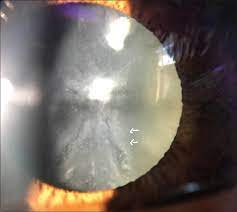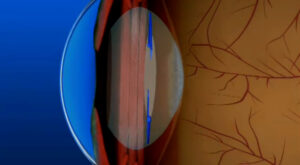Did you know that up to 50% of the world’s population has cataracts? And, according to World Health Organization, by 2030, cataracts will be the leading cause of blindness in the world. If you’re like most people, you probably didn’t know any of this. But, it’s important to understand these numbers just in case you or a loved one develops snowflake cataracts. In this blog post, we will provide you with a detailed guide on this type of cataract. We’ll talk about the symptoms and how to diagnose them, as well as discuss the treatments and surgeries available. We hope that this information will help you take steps to protect your vision and stay healthy.
Contents
What is a Snowflake Cataract?

A snowflake cataract is a type of cataract that results from the deposition of crystallized droplets (snowflakes) on the surface of the lens. These droplets can accumulate over time and may lead to partial or total obscuration of the lens. Snowflake cataracts are relatively rare and most commonly occur in people over the age of 50. They are more common in women than men and are more likely to occur in people with a family history of cataracts.
Symptoms of a snowflake cataract include difficulty seeing a bright light and near objects, blurred vision, and decreased vision in one or both eyes. If left untreated, a snowflake cataract can progress to complete blindness. Early diagnosis and treatment with surgery are usually successful, although there is a small risk of losing some sight as a result of the procedure.
The main causes of snowflake cataracts are age-related changes in the structure and function of the eye’s lenses. The crystallized droplets that form on the surface of the lenses cause them to become clouded and less able to transmit light effectively. Over time, this can result in gradual loss of vision.
There is no specific test that can be used to diagnose snowflake cataracts; however, if you experience any symptoms suggestive of this condition, it is important to see your doctor for an evaluation.
Symptoms of a Snowflake Cataract
There are many signs of snowflake cataracts, but some of the most common include :
Decrease In Eye-Vision
One of the most common signs of a snowflake cataract is a decrease in eye vision. In some cases, it can be so severe that you may not be able to see it at all. The eye vision also may become blurry, or you may see halos around objects. The decrease in vision can also cause you to have difficulty reading and driving.
Decreased Awareness In The Eye Area
Another sign of a snowflake cataract is decreased awareness in the eye area. This can be because your eye is not seeing as well as it used to, or it could be a symptom of another condition. In some cases, this reduced awareness can lead to blindness if not treated.
Constant Eye Pain
Many people also experience constant eye pain as a sign of a snowflake cataract. This pain can be because the cataract is pressing on the optic nerve, or it can be caused by other conditions that are affecting your eyes. The pain can be so severe that you may have to take medication to relieve it.
Feeling Like Your Eyes Are Swimming In Water
Another sign of a snowflake cataract is the feeling that your eyes are swimming in water. This is because the cataract has caused the lens to become cloudy and opacified. This can make it difficult to see, and you may also find it hard to focus on things.
Constant Headaches
Many people also experience headaches as a sign of a snowflake cataract. This is because the clouded lens can cause light to enter the eye inaccurately. This can lead to headaches, and in some cases, it can even cause blurred vision.
Feeling Confused Or Like You Are Having A Daze
Many people also experience feelings of confusion or like they are having a daze as a sign of a snowflake cataract. This is because the opacified lens can make it difficult to see clearly. This can lead to difficulty navigating your surroundings, and it can even cause falls.
Reasons for Snowflake Cataracts

Having snowflake cataracts is not always an indicator of a serious health problem. A snowflake cataract is simply a type of cataract that looks like small, fluffy snowflakes. They can form due to the accumulation of proteins and other materials in the lens of the eye. This can lead to clouding and eventually a permanent cataract.
Some of the other causes of snowflake cataracts, such as:
Genetics
One of the most common causes of snowflake cataracts is genetics. If your parents or other relatives have this condition, you are more likely to develop snowflake cataracts yourself. Also, genetics make it more likely that you will develop age-related cataracts, such as senile cataracts.
Age
As we age, our lens naturally starts to lose its ability to produce a clear lens. This can lead to the development of snowflake cataracts. These age-related cataracts are more common in women than men, and they usually develop between the ages of 50 and 70.
Fluoride Exposure
Some people are exposed to fluoride in water or food, which can increase the risk of developing snowflake cataracts. Fluoride can also damage the lens of the eye.
Lifestyle and Environment
Snowflake cataracts can also be caused by lifestyle and environmental factors, such as smoking and drinking. Environmental factors that can contribute to snowflake cataracts include: spending a lot of time in bright light; wearing contact lenses; using harsh chemicals; and being exposed to high levels of ultraviolet light.
Impacts of Having a Snowflake Cataract
The impacts of having a snowflake cataract may depend on the severity of the condition. If the cataract is minor, there may be no noticeable impacts. However, if the cataract is more severe, it may limit the vision of the individual. Additionally, depending on its location, a snowflake cataract may also cause pain when looking into bright light.
Some of these impacts of snowflakes cataracts are:
Double Vision
One of the most common impacts of snowflake cataracts is double vision. This occurs when the individual cannot see clearly due to the presence of two cataracts in the same eye. In some cases, this can be corrected with surgery. However, in other cases, double vision may be permanent.
Reduced Vision
If an individual has a snowflake cataract located in one of their better eyes, their vision may be reduced as a result. This is because the light that can enter the eye is blocked by the cataract.
Blurred Vision
Another common impact of snowflake cataracts is blurred vision. This occurs when the individual cannot see clearly because of the clouding caused by the cataract. This can make it difficult to drive or participate in other activities that require clear sight.
Pain When Looking Into Bright Light
Depending on where the snowflake cataract is located, it may also cause pain when looking into bright light. This is because direct light hits the clouded area of the lens and just as you are seeing this light it turns into a painful shadow again
Treatment of a Snowflake Cataract

There are many ways to treat a snowflake cataract. If the cataract is small, you might be able to fix it yourself with surgery. However, if the cataract is large or if it’s in an important eye area, you might need to have it surgically removed.
Some of the surgery options are:
Surgery
One of the most common ways to treat a snowflake cataract is to have it surgically removed. This is done by either removing the entire cataract using a surgery called a cataract surgery or by removing just the part of the cataract that is causing the vision problem.
Cataract Surgery
Cataract surgery is a very common procedure that is used to remove and fix cataracts. During cataract surgery, the surgeon removes the entire cataract using a special tool called a microscope. The surgery usually takes only a few minutes and most people recover completely within one week.
Laser Surgery
Sometimes, laser surgery is used to remove small, early-stage snowflake cataracts. This type of surgery uses a laser to heat the lens inside of the eye and break it down. This then allows the surgeon to remove it without having to go through the entire cataract. Laser surgery usually takes about 30 minutes and most people can go back to their normal activities within two days.
Glasses
Treating a snowflake cataract with glasses can help to improve vision. If the cataract is in an area that affects your vision, the doctor may prescribe a pair of glasses with special lenses designed to correct the vision issue caused by the cataract.
Contact Lenses
In some cases, contact lenses are prescribed to treat a snowflake cataract. Contact lenses can be used to correct the vision problem caused by the cataract, as well as provide an extra layer of protection from UV rays.
Lenses
Some snowflake cataracts can be treated with special lenses. Intraocular lenses are implantable lenses that are inserted into the eye to replace the cloudy lens caused by the cataract. This type of treatment is only used for more severe cases and requires surgery.
Lifestyle Changes
In some cases, lifestyle changes are recommended to help treat a snowflake cataract. For example, quitting smoking and wearing sunglasses when outdoors can help to reduce further damage from the cataract. Additionally, eating a healthy diet and getting regular checkups can help to prevent further complications.
No matter what treatment option is chosen, it’s important to follow up with your doctor regularly to ensure that the treatment is working as intended and to monitor any potential side effects. With proper treatment, a snowflake cataract can be managed successfully.
Conclusion
If you’re like most people, you’ve probably heard of cataracts but never really given them much thought. In this article, we’ll take a closer look at what a snowflake cataract is and how it can be diagnosed. We’ll also provide a detailed guide on how to treat and prevent snowflake cataracts so that you can live a long and healthy life with good vision. Thanks for reading.
Cataract surgery is a safe and painless procedure. At MantraCare we have a team of experienced eye surgeons, who will be happy to answer any questions on cataract surgery. Call us at +91-9711116605 for any inquiries.
